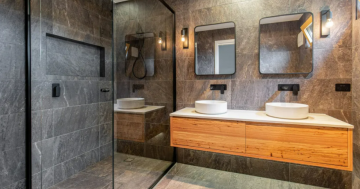
There are many elements to consider when designing a bathroom. Photo: Monaro Screens.
Designing a bathroom for a renovation or new build is an exciting project, but it’s easy to make a design mistake that will cost you time and cause frustration down the track. A professional can advise you on all the elements of your bathroom design that need to be considered to create a space that you and your family can enjoy.
Olivier and Lisha from Salt Renovations, as well as Ben from Monaro Screens, have shared their advice for what to look out for when designing your bathroom.
1. Be realistic about your space and budget
“The first thing is to be upfront about is your budget, as well as the space you’re working with,” says Olivier from Salt Renovations.
There is a common misconception that builders will try to push you to stretch your budget, even when things could be done for less. However, it’s actually vital for your builder to know what your limits are so they can make sure you’re getting the best outcome for what you’re willing to spend.
Lisha, Salt Renovations’ interior designer, says there are plenty of creative ways to make the most of the space you have available, but there are practical things that have to be considered too.
“One common example we see is people wanting free-standing bathtubs these days – but if there isn’t enough room to allow the necessary 250mm on either side of the tub to be able to clean it, you’re going to be stuck with a really frustrating situation to manage when you’re cleaning.”
Similarly, people need to consider the layout of the space they have, and how they can leverage it using design elements like recesses in showers instead of shelves, or how storage can fit in with your choice of vanity. The details really make a difference.
Ben from Monaro Screens says that getting your screens and vanities made to measure can also really help with making the most of your space.
2. Design is as important as function
There is a lot of value in engaging a designer early in the process and, as Lisha points out, there are lots of ways in which the design elements of your bathroom impact how the space feels. One example is the choice of tile size and grout colour.
“Grout colour makes a big difference to how your tiles look,” she explains. “If you choose a lighter grout with a darker tile, for example, the tile shape and colour will really stand out. Whereas more similar colours will blend in. And then you need to think about cleaning your tiles, and how noticeable you want any discolouration to be as the bathroom ages.”
Lisha works with her clients when they choose their colours, tiles and other fittings to help them get a sense of what the overall effect will be when everything is in place. It’s hard to visualise, but experienced designers and builders can help paint that picture for you.
Placement is also important.
“You don’t want the first thing you see when you open the bathroom door to be the toilet, for example,” Lisha says. “Or if you have a small space, having a shaving cabinet for storage might be better than crowding the space with a bulky vanity.”
3. Don’t be tempted by buying online
These days, you can find a lot of materials online for renovations, including tapware and fittings, tiles, cabinetry, etc. But Olivier warns that while it’s tempting to buy these items online yourself for lower cost, letting your builder order your supplies is definitely the way to go.
“There are so many things that can go wrong when you order through online suppliers, especially ones without a human contact point. Colours may not match, quality can really vary, and with things like tiles, you may not know what amount of wastage you need to incorporate for the space and to have as back up.
“Because we have relationships with our suppliers, we can troubleshoot when we need to, make sure you’re getting high quality materials, and also manage any issues that might come up. We’ve had clients who have bought their materials online, only for things to not look like they expected, for measurements to be off, or for fixings to be in different shades of the colour they chose.”
It might be slightly more expensive, but purchasing locally and through your builder will be better in the long run, and can save you from costly mistakes.
Ben adds that when a client comes in for an initial consultation, they can often troubleshoot together to find solutions for their bathroom design.
“Because we make everything to order, we can pretty much do whatever is needed to get the right solution for the space. But it’s much easier if we’re involved early in the process when the client first starts designing their bathroom with their builder.”
4. Don’t underestimate the emotional toll of getting it wrong
Finally, Olivier says it’s important to think about the process in the context of the impact on you and your family, especially if you’re renovating.
“A bathroom renovation can take six weeks minimum, and that’s time when you can’t use your amenities. Every time something goes wrong with the design or materials, you’re adding time to that process, and that can really start taking a toll. So getting it right at the design phase is so important to save you a headache down the track.”





















